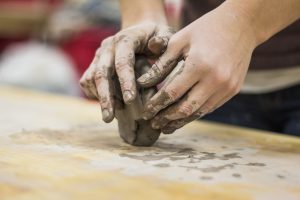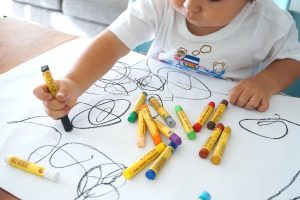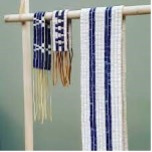Visual Arts
6.1 Supporting Visual Arts
Children have a natural fascination with the process of creating visual art. Making marks, squishing clay, and using a brush to apply color are activities that attract most young children. In groups where children speak multiple languages and may not share common words, visual art can create connections and a way of communicating. Art can become a way for people to connect across cultures to their common humanity; an appreciation for it may begin in preschool. Inviting families into the environment to share works of art from the home is an opportunity to build a bridge to the home.
Young children are naturally creative. The visual art framework is designed to encourage creativity; open-ended projects emphasize the process of working with visual materials. In other words, the curriculum is not focused on encouraging a child to produce, for example, a specific painting, but rather to practice using a brush on paper without a set product.
Educators can support the visual arts with the following:
- Encourage engagement with art when working with all age groups, infancy through school age.
- Support exploration and discovery.
- Give children the time and space needed to explore creativity.
- Provide a comfortable environment in which children can practice art.
- Provide opportunities for children to reflect on their own work.
- Respect individual developmental, cultural, and linguistic differences, and encourage children to respect them.
- Provide children simply with a means and place to make marks (e.g., a crayon and paper), and they will begin with the same basic images.
- Encourage communication around shape and form to aid children’s drawing skills.
- Help children acquire painting skills through practice with the tools.
- Stimulate children’s interest in color and application of paint through other forms of painting.
- Create opportunities for children to work with dough, clay, or wet sand.
- Provide only the malleable material, without tools, during children’s initial explorations of sculpting so that children have a chance to explore through touch.
- Communicate to a group of linguistically and culturally diverse children through sculpture techniques by using nonverbal methods.
- Introduce tools after observing that children have had many “hands-on” opportunities to explore clay and dough sculpture.

6.2 Suggested Materials for Visual Arts
Type of Materials |
Examples of Materials |
|
Found or Recycled Materials
|
Old books/magazines for cutting and assemblage, cardboard rolls and boxes, plastic lids and containers, fabrics.
|
|
Basic
|
Tempera paints, construction paper, chunky crayons, tray watercolors.
|
|
Enhanced
|
Tube watercolors and palette; watercolor paper.
|
|
Natural Environment
|
Sticks, rocks, and pinecones for sculpture; clay and natural materials for pressing.
|
|
Adaptive Materials
|
Thicker handles on some materials; easel that can be adjusted to angle and appropriate height.
|

6.3 Ideas for Visual Arts with School-Age Children
Integrating visual arts into the school-age curriculum is not as daunting as one may think. Visual arts lend themselves to naturalistic, holistic, and authentic learning. Visual arts integration does not mean integrating art for the sake of another subject; but integrating art for the arts’ sake to heighten children’s overall learning experience (Harris, 2011).
To start, think about the fundamentals of visual arts such as line, shape, and color. To teach the vocabulary words of color, the following terminology is suggested: saturation (the amount of intensity a color displays, either very bright or dim), hues (color used in any design in any pixel), tone/value (the amount of lightness in a color placed along a spectrum of black (no tone) to white (highest tone), shades (shades are created by taking a hue and adding pure black to create a new deeper color), and tints (similar except you add pure white to create a new color) (The Science Behind Design Color Theory, n.d.).
To successfully integrate visual arts, it is important for educators to go outside of their own box to new ideas and new learning; it is important to have “cross-disciplinary thinking, collaborative and intentional works, written reflections, revisions, documentation, exhibitions, and critiques-all of which being crucial towards holistic and authentic learning and instruction” (Harris, 2011, p. 21). Visual arts can be integrated into any subject; however, it requires the educator’s efforts for planning, researching, and reflecting (Harris, 2011).
When visual arts are added to the learning process, content learning becomes more tangible, personal, and meaningful. Visual arts allow children to engage in hands-on learning and inquiry-based learning. Visual arts add to children’s personal expression and creativity in the learning process. In other words, children are engaged in the learning process for deeper levels of learning when visual arts are integrated.
There are many activities that can help educators get a jumpstart in integrating visual arts in the classroom. Below are a few activity ideas for integrating visual arts in content areas:
Activity 1: Da Vinci’s Notebook: the educator shows the images to the children and then the children search images to brainstorm images for thoughts and themes for the Notebook. The educator should make sure the images are age-appropriate before letting children surf the web. This activity can be integrated into any subject area (Koonlaba, 2015).
Activity 2: Paper Sculpture Project. Children create paper sculpture projects. This could be integrated into history, writing, language arts, science, and math (Koonlaba, 2015).
Activity 3: Pop Art. Pop art is always very popular with children. The simple imagery is easy for them to imitate. It also engages in content areas (Koonlaba, 2015).
Activity 4: Class Comic Book. Create a class comic book by combining children’s art pieces and having them work together to write a story with a beginning, a middle, and an ending (Koonlaba, 2015).
Activity 5: Pyramid Art Project. A Pyramid could be painted/drawn/sketched. This could be used to connect art in math and social studies content areas.
Activity 6: Poster/Brochure/Advertisement Project. Ask children to create a poster, brochure, or advertisement. These art projects can be great alternative assessment products; they are also great tools to teach children about graphic design (Hayes, n.d.).
Activity 7: A Work of Art. Ask children to draw or make a collage about a specific topic they are studying in any content area. Cartoons are great to incorporate visual art with current events in social studies (Hayes, n.d.).
Indigenous Perspectives

Young children practice stringing beads together which improves hand dexterity in addition to colour recognition, counting, and patterning. This practice introduces children to wampum strings which have been used to relay important messages to other communities. Wampum strings woven together form binding agreements between nations such as the Two Row Wampum shown here. For additional information, see Two Row Wampum
Pause to Reflect
Adult colouring books are very popular to allow the brain to rest, reduce anxiety and generate mindfulness.
When was the last time you created for your own pleasure? Did you use to enjoy drawing, painting, and creating?
Take a few minutes to doodle- what happens to your thoughts? How do you feel?
Important Things to Remember
- Children have a natural fascination with the process of creating visual art.
- In groups where children speak multiple languages and may not share common words, visual art can create connections and a way of communicating.
- Educators can encourage creativity by providing open-ended projects that emphasize the process of working with visual materials (crayons, paint, brushes, clay, etc.) rather than creating an end product.
- Visual arts allow children to engage in hands-on and inquiry-based learning.
Supplemental Readings
References
Harris, S. F. (2011). Integrating visual arts into the curriculum. Retrieved from https://tspace.library.utoronto.ca/b…RP%20FINAL.pdf
Haynes, K. (n.d.). 12 ways to bring the arts into your classroom. Retrieved from http://www.teachhub.com/12-ways-brin…your-classroom
Koonlaba, A. E. (2015, February 24). 3 visual artists-and tricks-for integrating the arts into core subjects. Retrieved from https://www.edweek.org/tm/articles/2…gthe-arts.html
The science behind design color theory. (n.d.) Retrieved from https://designshack.net/articles/gra…-color-theory/

